60 Practice Exercises
Exercise: Safety Action
During a yearly safety assessment, you find that a pressure relief valve in a heat exchanger is rusted and may not open properly in case of a pressure build-up. What is the best course of action?
a) Report to the project manager and immediately replace the pressure relief valve
b) Operate the process at a lower pressure to reduce the risk of over-pressurizing
c) Ignore it because the probability of over-pressurizing is very low
Solution
a) Report to the project manager and immediately replace the pressure relief valve
Any safety hazard should be reported and addressed as soon as possible.
For b), Operating the process at a lower pressure does not completely eliminate risks and may reduce process efficiency. In the long run, this will cost more than a new pressure relief valve.
Exercise: OSHA Incident Rate for Exposure to Hazardous Materials
Suppose that a total of 12 operators have been exposed to leaking hazardous materials in a chemical plant. The total working hours that might expose the workers to the risk are 870,000 hours. Calculate the OSHA incident rate for exposure to hazardous materials.
Solution
\begin{align*}
\text{incident rate} & = \frac{\text{number of incident exposure}×200,000}{\text{number of working hours}}\\
& =\frac{12×200,000}{870,000}\\
& = 2.76
\end{align*}
Exercise: Pump Kickback Loop
Sometimes a kickback loop is added on a pump to prevent damage to the pump when the outlet stream is blocked:
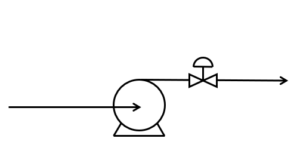
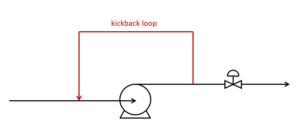
Compare the effect between the kickback loop is present or not when we close the valve (or when the stream after the valve is blocked), explain how the kickback loop prevents damage.
Solution
If no kickback loop present, the pump keeps doing work on the liquid before the valve, but the stream is not able to move forward. As a result, the stream will be heated up. If the stream vapourizes, the vapour may tear up the metal blade in the pump.
When there is a backflush cycle, the stream will circulate in the kickback loop, which increases the amount of liquid pumped and dissipates the heat.
Exercise: HCl Production What-if Analysis
Shown below is the simplified process of HCl production
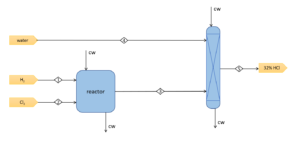
The following reaction happens in the reactor at a temperature of 900°C:
[latex]H_{2(g)}+Cl_{2(g)}\rightarrow 2HCl_{(g)}\;\;\;\;\;\Delta H=-92.3kJ/mol[/latex]
In the absorber, HCl gas is dissolved in a water stream ([latex]\Delta H[/latex] of solution = -74.8 kJ/mol), producing aqueous HCl solution
Perform what-if analysis regarding the following scenarios:
a) What if the cooling water stream in the reactor is blocked? State the direct consequences and recommendations.
b) If the cooling water stream in the absorber is blocked, how would the concentration of the product be affected?
Solution
a) If the cooling water stream is blocked, the temperature in the reactor will rise up due to the exothermic reaction. The gas in the reactor will expand, which leads to pressure increase and potential explosion.
Regular maintenance should be performed and a pressure relief valve should be installed in the reactor.
b) The absorber heats up as the process of HCl dissolving is exothermic. As the temperature increases, the solubility of HCl decreases, which leads to a lower concentration of HCl in the product.
Exercise: Glycerol Purification
We use a distillation column to purify a stream of glycerol with methanol impurities:
| Boiling Point (°C) at 1 atm | |
| Glycerol | 290 |
| Methanol | 65 |
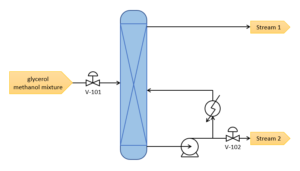
Base on the given information, answer the following questions:
a) What is the major component in stream 1 & 2?
b) Draw a control loop that regulates the rate of separation by controlling the level of the liquid in the column.
c) If the level in the column is too high, is the valve in the control loop open or closed?
d) Is there any safety hazard if valve V-102 fails closed?
Solution
a) Stream 1 is majorly methanol and Stream 2 is majorly glycerol.
Since methanol has a much lower boiling point than glycerol, methanol will mostly be in the vapour phase and glycerol will mostly be in the liquid phase when an appropriate temperature is selected for the distillation column.
1. Since vapour is lighter the liquid, vapour will exit at the top of the column and liquid will exit at the bottom
2. Pumps can only be used on liquid streams
3. The reboiler loop is on the liquid stream. It vapourizes part of the liquid and sends it back into the column to increase the rate of separation
b) 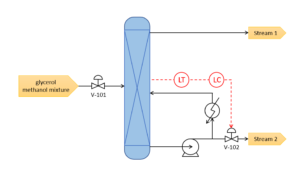
c) The valve in the control loop will be open. Because the valve is on the outlet of the liquid stream, opening the valve increases the flow of the liquid stream out of the column, decreasing the liquid level in the column.
d) There is no safety hazard, but it leads to ineffective separation.
When V-102 fails open all the liquid will be sent back into the column as vapour, which shifts the vapour-liquid equilibrium in the column.
Exercise: Nitric Acid Production
The following diagram shows the major process steps for the production of nitric acid.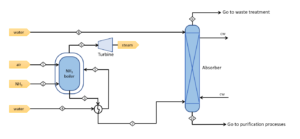
Air and ammonia are first sent to a boiler where the reaction produces nitric oxide, water vapor, and heat. The process stream is then cooled through a heat exchanger, where nitric oxide oxidizes into nitric acid as temperature decreases. The first stream used in the first heat exchanger is also used as a utility stream to absorb excess heat in the boiler and convert it into energy when going through a turbine. The process stream is then sent to an absorber where it is mixed with a stream of water to produce liquid nitrate acid. The liquid acid is sent to further purification processes while the vapour produced in the absorber is sent to waste treatment.
a) What are the direct consequences if stream 5 is blocked? Analyze the effect on the process in the [latex]NH_{3}[/latex] boiler and the first heat exchanger.
b) Using the description in the next paragraph, build a fault-tree analysis logic diagram on the risk of severe overpressure that could lead to an explosion in the absorber, and calculate the frequencies of all events in the diagram. Assuming all events with given frequencies are basic events.
Severe overpressure that could lead to an explosion happens when both system over maximum pressure and pressure relief valve fails happen at the same time. System over maximum pressure happens when the cooling water inlet is blocked (frequency = 0.015) or process vapour outlet stream is blocked (frequency = 0.008). Pressure relief valve fails happens when any one of the following circumstances happens: valve leaking (frequency=0.023), valve calibrated at a wrong pressure (frequency=0.005), or contaminants causing the valve to stick (frequency = 0.056).
Solution
a) The process stream in the heat exchanger will not be sufficiently cooled down, so the conversion to nitric acid will be lower, decreasing the concentration of the product in the absorber.
There will not be enough flow to absorb the heat in the boiler, which will lead to a temperature increase, pressure build-up and potential explosion of the gas in the boiler.
b)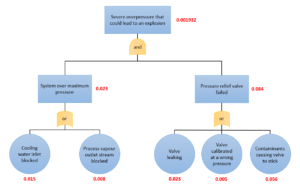


Feedback/Errata